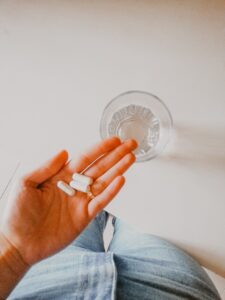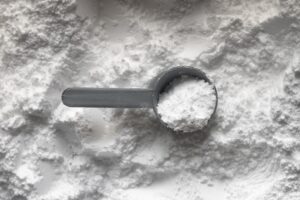What is Digestive Health
If you’ve been following the gut health and digestion series so far, we’ve been talking about several different places where there can be issues, or breaks in the chain of digestion. So far, we’ve covered what good digestion actually is, and then went on to talk about gut barrier dysfunction (leaky gut), and bacterial dysbiosis.
In this blog post, we’re going to be talking about stomach acid, digestive enzymes, and bile. Stomach acid can either be low or high, and many of the symptoms overlap considerably. Digestive enzymes are actually present all across the digestive system: in the mouth, in the stomach, in the small intestine secreted from the pancreas, and then the small intestine actually makes a few itself. Bile is created by the liver and stored in the gallbladder, and it helps to emulsify and digest fats, but it does a lot more than that. Bile is actually a critical signaling molecule as well.
We’re going to go through each of these parts of digestion individually, discuss how they overlap, and how you might identify what issue is present.
Table of Contents
High or Low Stomach Acid
The stomach is a pretty impressive organ and an essential component of good digestion. Evolution has found a way to secrete a very strong acid that would normally damage any other organ in the body, but the stomach wall has mechanisms in place to protect itself from its own acid. Having adequate stomach acid is incredibly important for several reasons:
- Stomach acid helps with the digestion of proteins and its presence is necessary for the absorption of minerals like calcium, zinc, magnesium, iron, and other important micronutrients like folic acid and vitamin B12
- It sterilizes; meaning it kills parasites, bacteria, and fungi that may be present on food. Low stomach acid is a primary risk factor for developing small intestinal bacterial overgrowth (SIBO).
- It signals other parts of the digestive tract that food is on the way, priming them and ensuring good digestion all the way down the gut.
Low Stomach Acid
If you have low stomach acid, you’re opening the door to the development of chronic digestive issues, as well as many different micronutrient deficiencies.
Risks of low stomach acid include chronic stress, being over 60, being anemic, long-term bulimia, having an autoimmune condition, chronic use of NSAIDs or other painkillers, and overconsumption of coffee and caffeine in those who are sensitive to it.
High Stomach Acid
Let’s also talk about high stomach acidity. High stomach acidity will be a little more rare than low stomach acidity, but it can still happen. The main harmful aspect of high stomach acidity is that it can potentially cause ulcers and gastritis, which is inflammation of the stomach lining.
If severe gastritis occurs, then the situation will flip, and the stomach will start producing significantly less acid, leading to low stomach acid. The main risk factors for high stomach acid include autoimmune conditions, food sensitivities, and H. Pylori overgrowth. H. Pylori more often causes low stomach acid, but depending on where it colonizes in the stomach and where in the course of the infection we’re at, it can potentially cause high stomach acid.
In terms of food sensitivities, if you have a food sensitivity, histamine tends to be released, which signals the stomach to produce more stomach acid. There are actually stomach acid-lowering medications that are histamine blockers — Zantac, for example, is an H2 blocker that reduces stomach acid.
Symptoms of a Stomach Acid Imbalance
As I mentioned earlier, the symptoms for low and high stomach acid overlap considerably — they both share the following symptoms:
- Burping/belching
- Feeling excessively full after not eating much food/feeling like food is just sitting in your stomach
- Feeling bloated or stomach distension
- Heartburn/acid reflux/gastroesophageal reflux disease (GERD)
Yes, acid reflux can even happen with low stomach acid. It can actually occur with any level of stomach acid and isn’t necessarily a problem of stomach acid levels, but more generally a problem of luminal esophageal dysbiosis, or dysbiosis of the microbiome at the bottom of the esophagus.
In any case, low stomach acid can also potentially contribute to gastroesophageal reflux disease (GERD) because the lower esophageal sphincter also needs a certain amount of stomach acid to signal its closing. If it doesn’t close, even the small amount of stomach acid that’s present can reflux into the esophagus. Whatever issue is causing the low stomach acid can also potentially be contributing to the aforementioned esophageal dysbiosis as well.
Let’s talk about symptoms that distinguish low stomach acid from high stomach acid. High stomach acid can have these additional symptoms that aren’t present with low stomach acid:
- A feeling of burning pain or discomfort in the upper abdomen below the chest, even on an empty stomach.
- Fatty food intolerance
- Nausea and occasional vomiting when/after eating
There are numerous other ways we can parse out low vs. high stomach acid, from clinical tests, which are the gold standard, to significantly rougher ways that aren’t necessarily diagnostic but can help point you in the right direction.
The gold standard is going to be a Heidelberg Stomach Acid test. This is only done in clinics, and you’ll rarely get a Western medicine doctor to run this, however. The patient generally swallows a capsule with a radio transmitter inside and then drinks a baking soda solution to neutralize the stomach acid. The radio transmitter then measures how fast the stomach acid returns to normal, and, based on the results, it can diagnose low stomach acid.
Since nearly nobody will have access to this unless there’s a very serious issue, here are a few easy, but slightly less reliable at-home tests:
- Baking soda test: Dissolve ¼ tsp of baking soda in 4 oz of water and drink, then time how long it takes you to burp. If you don’t burp after 3-5 minutes, chances are you have low stomach acid.
- Note the possibility of swallowing air with the solution; if you have one small burp immediately and then nothing for 3 minutes, there’s a good chance that it was just swallowed air.
- Betaine HCl challenge
- Considered slightly more accurate than the baking soda test. When you eat a meal, take betaine HCl pills mid-meal. Start with 1 and wait a few minutes, then take another. Repeat this until you feel a burning sensation in your stomach. The next time you eat, your dose will be 1–2 pills less than that. If you feel a burning sensation after 1–2 pills, then your stomach acid levels are most likely fine.
What do Digestive Enzymes Do?
As I mentioned before, digestive enzymes are an important aspect of the digestive system and are found all along the digestive tract.
Digestive Enzymes in the Mouth
By chewing longer, you allow your salivary amylases and lipases (carb and fat-digesting enzymes) to act on the food for a longer period of time, taking a load off the rest of the gut. The importance of slower eating and chewing your food well cannot be understated!
Digestive Enzymes in the Stomach
Gastric proteases (protein digesting) and lipases (fat digesting) further break down food in the stomach. Gastric proteases specifically also need adequate levels of stomach acid to become active.
Digestive Enzymes in the Pancreas
The majority of enzymatic digestion comes from secretions from the pancreas. The pancreas secretes proteases, lipases, and amylases into the first part of the small intestine for continued digestion.
Digestive Enzymes in the Small Intestine
Finally, there are enzymes along the small intestinal wall that break down any small food particles remaining into their foundational constituents (sucrose into glucose and fructose, for instance).
Since there are many organs along the digestive tract that secrete enzymes, all it takes is one of those links in the chain to start secreting less to have digestive issues. If you aren’t chewing enough, you’ll have less salivary enzyme action, which puts more of a load on the stomach and other organs to ensure good digestion. This is why it’s crucial to chew your food well if you think you’re already suffering from low stomach acid.
If you have stomach inflammation for any reason, you’re most likely going to have less active proteases and perhaps lipases.
As far as the pancreas goes, if you have type 1 diabetes or advanced type 2 diabetes, you’ll going to have less pancreatic enzyme secretion. There’s also evidence that some cases of IBS involve a component of lower pancreatic enzyme secretion. One study found that 6.1% of people with IBS had pancreatic enzyme insufficiency, so it’s not necessarily too common. If you have digestive issues, it’s more likely an issue elsewhere.
Finally, if you’ve got gut barrier dysfunction, the enzymes along the intestinal wall are going to be depleted as well.
Finding Issues in the Digestive Tract
Now that you know what digestive enzymes do, it might be intimidating to try and figure out where a potential digestion issue might lie. The good news is that I wouldn’t try to worry over where the source of a possible enzyme deficiency is or even if you have enzyme deficiency vs. other issues like leaky gut/dysbiosis.
The solution is the same; work digestion basics, and if that doesn’t work, initiate a gut protocol involving the elimination of offending foods along with targeted supplementation.
Part of that targeted supplementation will be digestive enzymes, which can be used alone as well. We’re looking for a supplement with at least a good amount of proteases, lipases, amylases, peptidases, and other things like bromelain would be a bonus. If you have gut issues, a digestive enzyme supplement is safe to add, and studies show great efficacy as part of a treatment protocol for IBS.
How Bile Impacts Digestion
Bile is a substance that is created in the liver from cholesterol and is stored in the gallbladder for easy release into the small intestine. It’s actually one of the main disposal routes of cholesterol in the body.
Bile emulsifies fats at the beginning of the small intestine. You can think of it as a hammer that smashes large lipid droplets into tiny ones to increase their surface area so that lipases can act on them to finish fat digestion. There are several aspects of bile that can be off; we can have too much bile release, we can have too little bile release, or we can lack reabsorption.
Nearly 100% of bile that’s released into the small intestine is reabsorbed at the end of the small intestine. One of the reasons fiber and fiber supplements can help lower cholesterol is because they trap bile in the intestines and prevent it from being reabsorbed, which causes the liver to use cholesterol to make more.
In any case, it’s been known that approximately 25–33% of individuals with IBS-D (diarrhea-dominant IBS) suffer from bile acid malabsorption, so having unregulated bile acid release and bile acid reabsorption issues is most likely more common than not having enough bile.
A current hypothesis about how this may occur involves SIBO and other forms of dysbiosis disrupting bile signaling, which causes bile not to be reabsorbed. If certain bacterial populations in SIBO are present, they create beta-glucuronidases, which modify bile acids and prevent them from binding to the correct receptor, which ultimately prevents them from being reabsorbed.
Not only will this cause malabsorption diarrhea, but I also mentioned earlier that bile acids are also a critical signaling molecule. If the bile acids can’t bind to their receptors which causes reabsorption, they also can’t bind to the receptors that regulate metabolism. Bile acids play a strong role in both lipid and glucose homeostasis, altering insulin sensitivity negatively if they can’t do their job, and they also play a role in immune system homeostasis as well.
If tons of bile acids are reaching the large intestine, as in bile acid malabsorption, this will induce serious dysbiosis there, since bile acids are heavily antimicrobial. Bile acids are one of the main reasons the small intestine has a lower level of bacteria normally, and it’s seen in literature that if we experimentally stop bile flow in animals, they develop SIBO almost instantly. This has implications for bile acid deficiency and SIBO.
How to Test for Bile Issues
A rough test (not diagnostic) to see whether we’re dealing with bile acid malabsorption or bile acid deficiency, specifically in IBS-D, is testing with a few supplements. Since gel-forming fibers trap bile and prevent them from causing diarrhea, if you supplement a psyllium husk fiber supplement with every meal and this alleviates your diarrhea, there is most likely bile acid malabsorption happening.
On the other side of things, if you take an ox bile supplement with meals and this takes care of your diarrhea, then it was most likely a bile acid deficiency.
The gold standard is the 75Se HCAT test, which isn’t available in the US. The US gold standard is the 48-hour fecal bile acid collection done in-clinic. It’s still rather rare that a gastroenterologist will run this. A blood test called 7αC4 can also be used, although this is another one that’s quite hard to get as well.
Bile acid malabsorption can eventually turn into bile acid deficiency, however. Since malabsorption causes the liver to continue to make more bile. Whereas this doesn’t happen in normal physiology, the liver can begin to produce less when stressed to produce more.
Fortunately, bile acid supplements are relatively cheap and widely available and are also safe to supplement even if you’re not 100% sure you have bile acid malabsorption or insufficiency. Ideally, you want to look for a supplement that lists each bile acid and the amounts.
Conclusion on Digestion
That wraps up the final part of our four-part series on digestion. If you have a client with bad gut issues, diagnosed IBS, SIBO, etc., digestive enzymes and bile acid supplements are a safe bet to add to improve your client’s digestion. I’d make enzymes of first priority since it’s more likely they’re needed.
Check to see if your clients are suffering from a stomach acid issue. I’ve noticed in my personal experience one of the most prominent giveaways for a stomach acid issue is that feeling of food just sitting in the stomach like a rock, and/or having very early satiety from meals. If you notice that, try one of the tests above to see which issue it might be.
If you want to become a master of dealing with gut issues and truly be able to hash all this out for yourself; this is exactly what we do within our Metabolism School program, FNMS. If you’d like to learn more to see if you’re a fit, check it out here.
References
Talley NJ, Holtmann G, Nguyen QN, Gibson P, Bampton P, Veysey M, Wong J, Philcox S, Koloski N, Bunby L, Jones M. Undiagnosed pancreatic exocrine insufficiency and chronic pancreatitis in functional GI disorder patients with diarrhea or abdominal pain. J Gastroenterol Hepatol. 2017 Nov;32(11):1813-1817. doi: 10.1111/jgh.13791. PMID: 28332731.
Majeed M, Majeed S, Nagabhushanam K, Arumugam S, Pande A, Paschapur M, Ali F. Evaluation of the Safety and Efficacy of a Multienzyme Complex in Patients with Functional Dyspepsia: A Randomized, Double-Blind, Placebo-Controlled Study. J Med Food. 2018 Nov;21(11):1120-1128. doi: 10.1089/jmf.2017.4172. Epub 2018 Aug 29. PMID: 30156436; PMCID: PMC6249666.
Money ME, Walkowiak J, Virgilio C, Talley NJ. Pilot study: a randomised, double blind, placebo controlled trial of pancrealipase for the treatment of postprandial irritable bowel syndrome-diarrhoea. Frontline Gastroenterol. 2011 Jan;2(1):48-56. doi: 10.1136/fg.2010.002253. Epub 2010 Nov 3. PMID: 22095308; PMCID: PMC3009417.
Leeds JS, Hopper AD, Sidhu R, Simmonette A, Azadbakht N, Hoggard N, Morley S, Sanders DS. Some patients with irritable bowel syndrome may have exocrine pancreatic insufficiency. Clin Gastroenterol Hepatol. 2010 May;8(5):433-8. doi: 10.1016/j.cgh.2009.09.032. Epub 2009 Oct 14. PMID: 19835990.
Vijayvargiya P, Busciglio I, Burton D, Donato L, Lueke A, Camilleri M. Bile Acid Deficiency in a Subgroup of Patients With Irritable Bowel Syndrome With Constipation Based on Biomarkers in Serum and Fecal Samples. Clin Gastroenterol Hepatol. 2018 Apr;16(4):522-527. doi: 10.1016/j.cgh.2017.06.039. Epub 2017 Jun 27. PMID: 28666948; PMCID: PMC5745308.

















